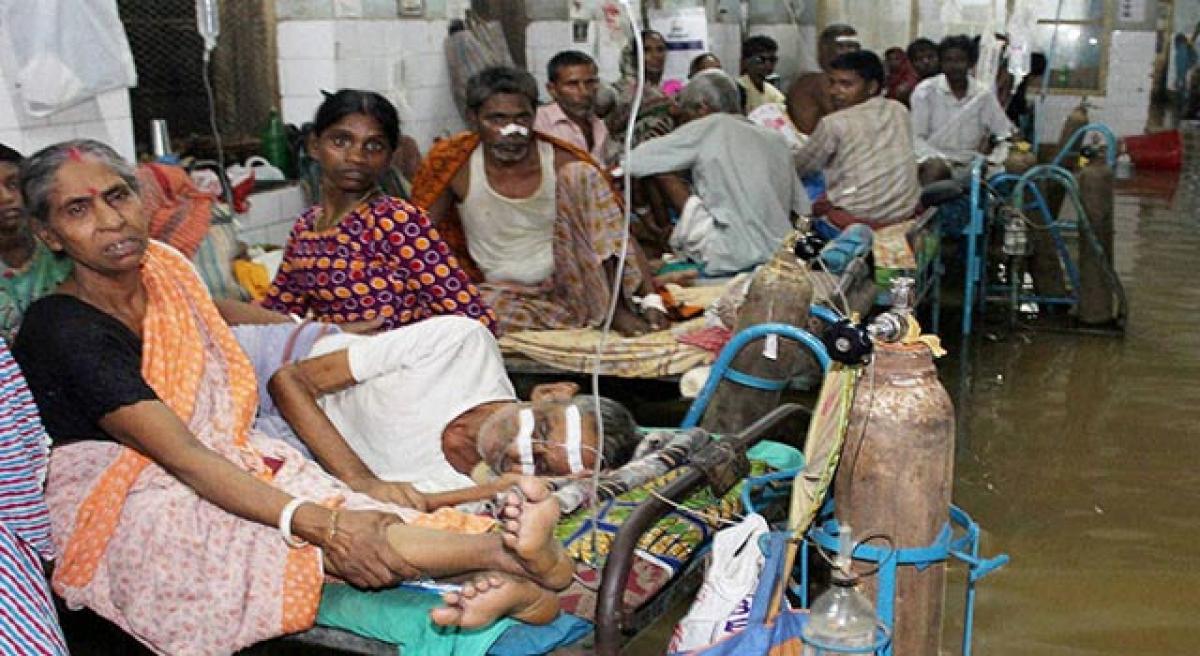Live
- Latvia to ban cellphones in elementary schools
- MP: Bilkhiriya Kalan residents reap benefits of Jal Jeevan Mission scheme
- MP govt preparing training guide for growth of school children
- India bids tearful adieu to icon Ratan Tata, thousands join his final journey
- A fast-paced flick of the hunter and the hunted
- Prasanth Varma unleashes first female Indian superhero from PVCU 'Mahakali'
- Rana launches FL &title of 'Khel Khatam Darwajaa Bandh'
- RK films acquires Telugu rights of 'Jhansi IPS'
- 'The Great Pre Wedding Show' launched traditionally by Rana Daggubati
- Odisha: Guidelines issued for Shahid Madho Singh Haath Kharcha Yojana
Just In

According to a new index developed to make the assessment of each country’s healthcare achievements, India ranks 143 in a list of 188 countries, six places ahead of Pakistan and way behind countries like Sri Lanka (79), China (92), even war-torn Syria (117) and Iraq (128).
According to a new index developed to make the assessment of each country’s healthcare achievements, India ranks 143 in a list of 188 countries, six places ahead of Pakistan and way behind countries like Sri Lanka (79), China (92), even war-torn Syria (117) and Iraq (128).
The first global analysis that assesses countries’ rankings based on sustainable development goals (SDGs) and health performance was launched at a recent special event at the UN General Assembly and published online in The Lancet.
The study, ‘Global Burden of Disease (GBD),’ analysed each country’s progress towards achieving health-related SDG targets by creating an overall SDG Index score. Countries that were ranked by their scores show which nations are close to achieving the targets.
In 2015, the UN General Assembly set the Sustainable Development Goals as 17 universal goals, 169 targets and 230 indicators to guide a range of pressing problems including food and water security, poverty and climate change up to 2030. Health is at the core of the SDGs and the third SDG aims to ensure healthy lives and promote well-being at all ages.
The study has warned that many countries may face substantial challenges due to an increase in childhood obesity and alcohol consumption rates. However, more than three-fifths of countries have already met the targets on reducing maternal and child mortality.
Health in India
One of the major health-related indicators is Malaria. Countries like Sri Lanka, Iraq, Syria, Libya and others have completely eliminated Malaria and scored 100 on this particular health indicator, while India has secured merely 10 points.
Another health indicator is under-five mortality. The target for achieving Millennium Development Goals (MDGs) was 2015. India is close to achieving the MDG goal of 42 deaths per 1,000 births and in 2014 – India registered 45 deaths per 1,000 births. On a scale of 0-100, India has a score of 39 on this front.
On the indicator of safe hygiene practices, India has secured just 8 points on the scale of 0-100. India score has been 93 on the war indicator front that assesses age-standardized death rate due to collective violence and legal intervention, per 100,000 population. Countries like Syria, Iraq, Libya and Pakistan have registered single digits.
The study pointed out that the reason for India’s worst-performance in health is because its political and medical classes have persistently ignored public health principles which ultimately improve a nation’s health, such as addressing social determinants of disease and ensuring high-quality, accountable, universal healthcare for people.
The public health sector is understaffed, underfinanced and that the hospitals maintains very poor standards of hygiene, forcing many people to visit private medical practitioners and hospitals. There is also a huge dearth of medically insured population in the country, and there is a high out-of-pocket expenditure.
Delhi has seen unfolding of mosquito-borne diseases like Chikungunya, dengue. Organ transplant racket is thriving largely in the country. Besides incidents like that of Dana Majhi, a tribal man who carried his wife’s dead body, on his shoulders for nearly 12 km as he had no money for a mortuary van and refusal of district hospital authorities, show how India is still stuck in the cesspool of power and money.
Disheartening figures
India’s spends just 1.2 per cent of its GDP on health, one of the lowest in the world. The US spends 8.3 per cent, China 3 per cent and the global mean is 5.4 per cent. On the other hand, India spends 2.3 per cent of its GDP on defence expenses.
India registers world’s highest deaths of mothers. The maternal mortality rate in the country is 178 out of 1,000. Forty seven per cent of under-five children in India are malnourished, the highest in the world.
World health Organisation (WHO) recommends 3.5 hospital beds per 1,000 people, while India has 0.7 beds per 1,000 people. With only one doctor available for 1,700 people, India needs at least 3,00,000 more doctors by 2020.
Nearly one million Indians die every year due to inadequate healthcare facilities and close to 700 million people have no access to specialist care.
Way forward The report noted that like as in other countries, the Indian government is planning to adopt world’s largest universal health insurance programme, partially inspired by US President Barack Obama’s grand insurance-for-all project which is as ‘Obamacare.’
But, this will not only be the solution. In a country with the lowest public spending in healthcare and highest out-of-pocket financing, the government has to ensure all their welfare schemes reach the poorest states having the highest deaths. More medical staff, midwives, paramedics have to be brought into action.
By Gudipati Rajendera Kumar

© 2024 Hyderabad Media House Limited/The Hans India. All rights reserved. Powered by hocalwire.com







